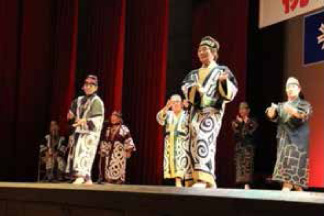- Theme C:
Learning about and enjoying the symbiosis between humans and nature from history -
- 1. Hokkaido's original inhabitants came from the north
- 2. The hardships of the Ainu people and their restoration as an indigenous community
- 3. Prosperity brought to Hokkaido through distribution routes
- 4. Samani Mountain Path (Hokkaido's first national highway) and Tojuin Temple (one of the Three Temples of Ezo)
- 5.Living together with the sea
- ※Choose the desired content.
The culture of Hokkaido's indigenous Ainu people is considered to have originated with the marine-centered Okhotsk culture that prevailed from the 5th century to the 9th century and Satsumon culture, which developed under strong influence from the culture of Honshu (Japan's main island) and thrived from the 7th century to the 12th century. However, as Ainu culture (13th - 18th century) was established during a period of transition from pottery and stone implements to ironware and from pit dwellings to pillar-supported buildings, the number of archaeological finds and sites from the era is very small, and the process behind the culture's establishment is not yet fully understood. Among archaeological sites, forts (known as chashi in the Ainu language) offer valuable insights into the everyday lives of Ainu people from the time. More than 500 chashi have been found in Hokkaido. In Samani (Mt. Apoi Geopark) too, a chashi is known to have been located atop Cape Enrumu, and another is considered to have been situated on Mt. Kannon.


Cape Enrumu (right) and Mt. Kannon (left) - considered to have been chashi sites
While the Ainu subsisted on hunting, fishing and gathering, they were also a trading people who traveled across the Tsugaru Strait to Honshu and across the Soya (La Perouse) Strait to Sakhalin and the continent. However, the increasing number of wajin (people of ethnic Japanese descent) from Honshu who settled in Hokkaido in subsequent years gradually wrested the initiative of free trade from the Ainu. When a trading system favoring wajin was established by the Matsumae clan in the 18th century, Ainu people, who had been producers and trading partners with the wajin, were forced to work for them and suffered great hardships, including discrimination and forced assimilation by the wajin.
In the 20th century, efforts to restore the Ainu as an indigenous people gained momentum. They were encouraged to engage in activities that would preserve their unique language and traditional rituals as well as other aspects of their culture. These included the organization of Ainu language workshops, the production of woodcarvings and embroidery with Ainu designs, and the preservation of traditional dance. In 1984, Ainu dancing, which is carried on by 17 local preservation groups, was designated as an Important Intangible Folk Cultural Property of Japan in the name of the Traditional Ainu Dance in Hokkaido, and the Ainu Culture Promotion Act was enacted in 1997. In Samani too, initiatives to promote indigenous culture have remained ongoing, including the preservation of traditional dance and the restoration of cise (traditional Ainu dwellings).


Traditional Ainu dance (an Important Intangible Folk Cultural Property of Japan) by members of the Samani Minzoku Bunka Hozonkai (Samani Folk Culture Preservation Society) , and a restored cise (traditional Ainu dwelling)



